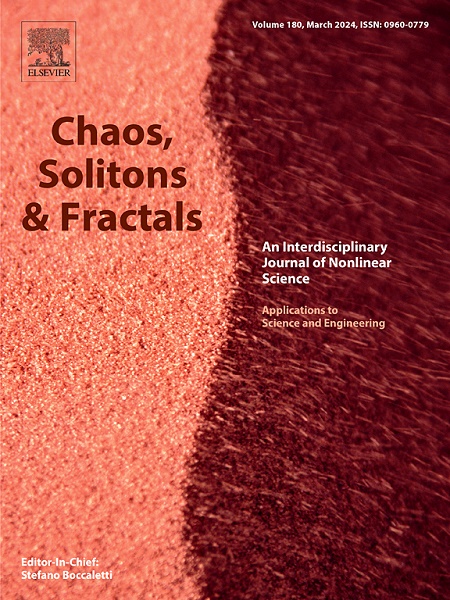Explosive transitions in aging dynamics of coupled Hindmarsh-Rose neurons with distance-dependent interactions
IF 5.3
1区 数学
Q1 MATHEMATICS, INTERDISCIPLINARY APPLICATIONS
引用次数: 0
Abstract
The abrupt onset of deterioration can have a profound impact on real-world situations, making it crucial to understand this process in order to prevent such events before they arise. In particular, understanding the dynamics of explosive transitions and aging behaviors in neural systems is essential for mitigating harmful illnesses. Importantly, we focus on such phenomena in coupled systems with distance-dependent interactions. Therefore, we primarily investigate the aging dynamics of globally coupled Hindmarsh-Rose (HR) neurons with distance-dependent interactions, concentrating on key factors such as coupling strength, inactive ratio, and decay rate that drive transitions between oscillatory and aging states. Through the use of the amplitude order parameter and bifurcation analysis, we identify the emergence of aging behaviors. Our findings show that increasing both the coupling strength and inactive ratio expands the aging region, while higher decay rates reverse aging dynamics by restoring rhythmic behavior. Importantly, we demonstrate bistability between aging (AG) and cluster oscillatory states (COS), exhibiting hysteresis characteristics. These results are validated through bifurcation and basin of attraction analysis, confirming the coexistence under varying initial conditions using a reduced model approach. Additionally, we explore the existence of explosive transitions and aging dynamics within complex network topologies, including small-world and random interactions. These findings significantly enhance our understanding of aging mechanisms in neural networks, with broader implications for brain aging, neuronal dysfunction, and other biological systems.
具有距离依赖相互作用的耦合Hindmarsh-Rose神经元衰老动力学中的爆炸性转变
突然发生的退化可能对现实世界的情况产生深远的影响,因此了解这一过程至关重要,以便在此类事件发生之前进行预防。特别是,了解神经系统中爆炸性转变和衰老行为的动力学对于减轻有害疾病至关重要。重要的是,我们将重点放在具有距离依赖相互作用的耦合系统中的这种现象。因此,我们主要研究具有距离依赖相互作用的全局耦合Hindmarsh-Rose (HR)神经元的衰老动力学,集中研究耦合强度、非活性比和衰减率等驱动振荡和衰老状态转换的关键因素。通过振幅阶参数和分岔分析,确定了老化行为的产生。我们的研究结果表明,耦合强度和非活性比的增加扩大了老化区域,而更高的衰减率通过恢复有节奏的行为来逆转老化动力学。重要的是,我们证明了老化(AG)和簇振荡状态(COS)之间的双稳定性,表现出滞后特性。通过分岔和吸引盆分析验证了这些结果,并利用简化模型方法证实了在不同初始条件下的共存。此外,我们还探讨了复杂网络拓扑结构中爆炸性转变和老化动力学的存在,包括小世界和随机相互作用。这些发现显著增强了我们对神经网络老化机制的理解,对脑老化、神经元功能障碍和其他生物系统具有更广泛的意义。
本文章由计算机程序翻译,如有差异,请以英文原文为准。
求助全文
约1分钟内获得全文
求助全文
来源期刊

Chaos Solitons & Fractals
物理-数学跨学科应用
CiteScore
13.20
自引率
10.30%
发文量
1087
审稿时长
9 months
期刊介绍:
Chaos, Solitons & Fractals strives to establish itself as a premier journal in the interdisciplinary realm of Nonlinear Science, Non-equilibrium, and Complex Phenomena. It welcomes submissions covering a broad spectrum of topics within this field, including dynamics, non-equilibrium processes in physics, chemistry, and geophysics, complex matter and networks, mathematical models, computational biology, applications to quantum and mesoscopic phenomena, fluctuations and random processes, self-organization, and social phenomena.
 求助内容:
求助内容: 应助结果提醒方式:
应助结果提醒方式:


